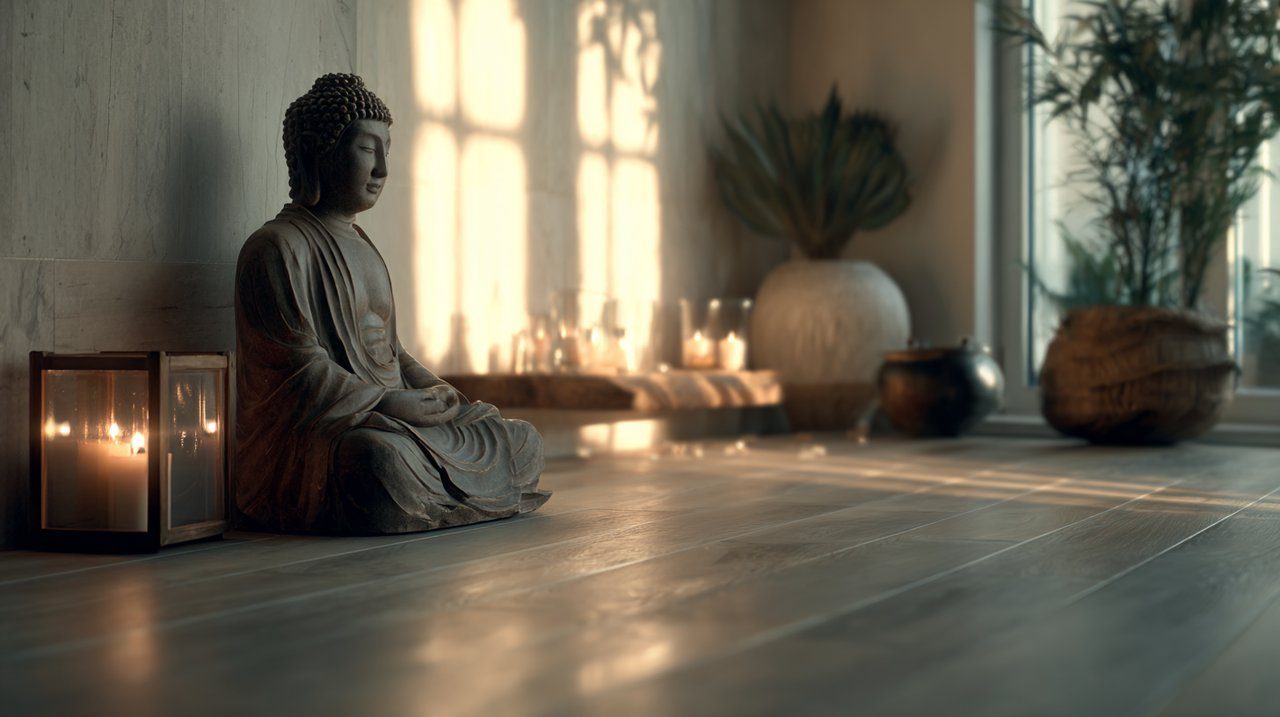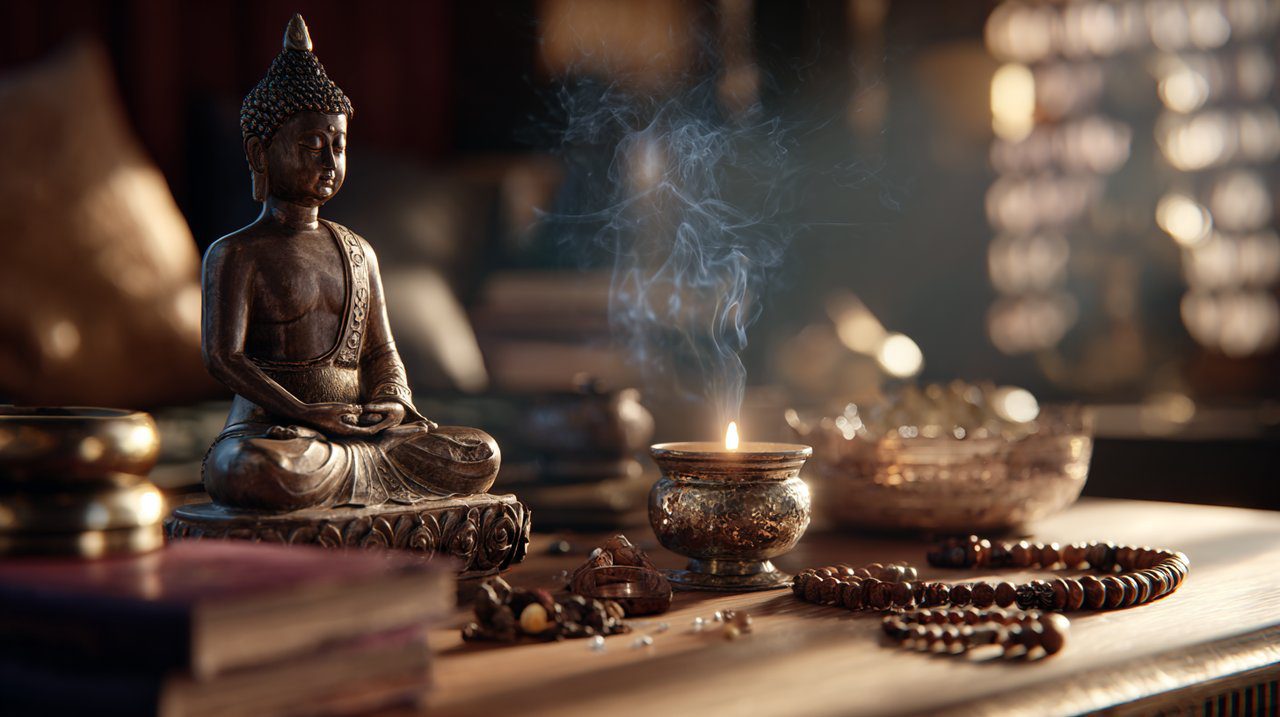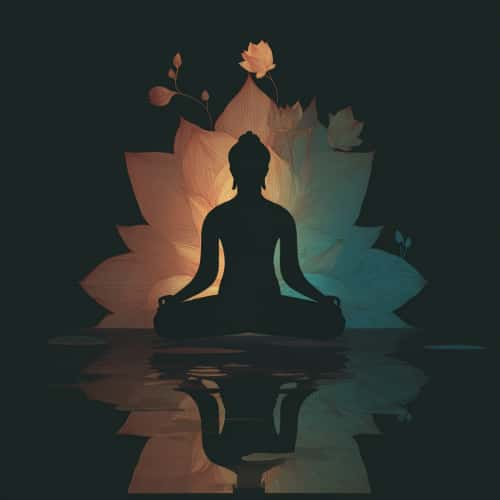Crafting Your Home Sanctuary: A Guide to Serene Reflection with a Buddha and Candle Holder
When the world’s insistent rhythm feels overwhelming, a quiet yearning arises for a space where the mind can settle, a place to return to our breath and our center. Crafting such a haven extends beyond mere decoration; it is an intentional act, a gentle ritual of cultivating stillness. How might a simple corner become a grounding presence for your journey toward inner calm? Here, we explore how the mindful arrangement of a buddha statue and a candle holder can transform any spot into a sanctuary, a true example of thoughtful sacred space design.
Sanctuary’s Foundation: Selecting Your Quiet Corner
The journey to your inner refuge begins with a deliberate choice: finding a place that naturally invites stillness. Establishing the right environment is the first, gentle step in crafting your personal sanctuary.
Seek an undisturbed spot within your home. This might be a quiet corner in your bedroom, a discreet nook in the living area, or even a dedicated shelf in your home office. The size of the space matters less than its capacity for quiet. Even a small, uncluttered area, distanced from daily commotion, can become a clear signal to your inner self: this is a zone for quiet contemplation. As you settle into this space, observe the subtle shift: perhaps a release of tension, a softening of the mind. The intention behind your spiritual decor and home altar setup guides its spirit, allowing a sanctuary to flourish even in limited areas. In shared environments or smaller apartments, a dedicated windowsill or a carefully arranged tray can become your personal anchor for peace. These physical elements serve as gentle invitations to connect with the sanctuary that already resides within you.

Intentional Placement: Buddha and Candle as Anchors
With your chosen space prepared, the next step involves the mindful arrangement of your buddha statues and candle holder. This conscious placement elevates these objects, transforming them into tangible anchors for your inner practice.
As you prepare for contemplation, position the buddha statues at eye level or slightly below. This height fosters a sense of equality and respectful connection, allowing its quiet presence to meet your gaze directly. Observe the mudra, the symbolic hand gesture—perhaps a gesture of meditation (Dhyana), wisdom (Bhumisparsha), or fearlessness (Abhaya). Each mudra carries ancient significance, subtly guiding your inner state. Consider the statue’s material: carved wood, polished bronze, or smooth stone. Each offers a distinct tactile and visual quality that can deepen your connection, inviting a different resonance. The candle holder finds its place nearby, its soft glow highlighting the Buddha’s expression without overpowering it. To nurture focus, arrange your space away from busy pathways or direct sightlines to doorways, which can interrupt your quiet state. Our intention is to craft a focal point that gently draws your gaze inward, inviting you to simply be. Understanding these nuances can greatly enrich your experience, guiding your choice for a personal buddha statue. 仏陀ミニチュア像:意味、配置、選び方の究極ガイド
Candle’s Glow: A Beacon for Focused Presence
The flickering flame of a candle can become a potent anchor for your meditation practice, transforming simple light into a quiet guide for your inner journey.
Within this sacred setting, the candle offers more than mere illumination. Its soft, dancing light naturally draws your attention, providing a quiet focal point for your gaze. The subtle glow and warmth invite a sense of calm, acting as a gentle reminder of the inner light we each carry. For those who wish to deepen their focus, an ancient gazing practice called Trataka can be integrated. To practice, sit comfortably and gently gaze at the flame without straining your eyes. Allow your mind to settle on this single point, observing the light without judgment. This systematic mindfulness practice helps steady the mind, enhancing concentration and inner quiet. When selecting your candle, consider unscented options to maintain clarity of the senses, or a subtly scented one, perhaps a calming home fragrance like sandalwood or lavender, to gently deepen your practice without distraction. The simple act of lighting this candle can become your first intentional ritual, a signal that your dedicated time for stillness has begun. It is a beautiful way to gently shift your mind from daily tasks to a state of peaceful readiness, a quiet acknowledgment of your commitment to yourself and your inner peace practices.
Enhancing Harmony: Thoughtful Additions
While the heart of a sanctuary often lies in its simplicity, thoughtfully chosen complementary elements can deepen its sensory harmony. These additions invite a richer, more embodied meditative experience.
- You might place a small meditation altar as a base, offering a dedicated spot for other tools.
- Perhaps a delicate incense holder to introduce calming aromas, preparing the air for stillness.
- Or a singing bowl, its resonant tones inviting soothing sounds that wash over your space, offering unique singing bowl uses for relaxation.
- Consider also a small cluster of healing crystals like amethyst (known for its calming energy) or clear quartz (for clarity and amplification), chosen for their specific properties and placed with intention.
Simplicity often holds the most profound power.
Choose only what truly resonates with you, and avoid anything that feels like clutter. Even mala beads, used for counting mantras or simply held, can become cherished mindfulness tools—held gently in your hand or resting quietly nearby. A simple practice to maintain the clear energy of your space involves gently dusting and tidying your items regularly. Approach this with a soft cloth and a moment of quiet gratitude for their presence. Understanding the rich history and spiritual power of elements like sandalwood incense can further enrich your practice. Sandalwood Incense: A Guide to Its Sacred History, Spiritual Power, and Conscious Use

Sustaining Presence: Daily Rituals
A truly quiet space comes alive not merely through its physical elements, but through the consistent rituals we weave around it. These practices transform it into an active, living part of our daily journey, echoing principles found in buddhist philosophy about mindful living.
Cultivating a consistent ritual around your buddha statues and candle holder transforms them from static objects into living invitations for presence. This might be as simple as lighting your candle at the same time each day, taking a few deep breaths, and sitting in quiet contemplation. It is not about rigid rules, but about creating gentle anchors throughout your day. This consistent, quiet engagement builds a beautiful mental association between your sanctuary and states of peace. As you engage with this space, allow yourself to notice a subtle shift: perhaps a softening of tension, a clearer mind, a deepening of your breath. Can you feel the nervous system settling? Even a few moments of focused presence can create a significant shift within you, gradually guiding your inner landscape towards greater calm and sustained presence.
Light and Form: Weaving Deeper Presence
The interplay between the candle’s soft glow and the buddha statues' still form is where the true essence of this sanctuary reveals itself. It moves beyond mere visual appeal, inviting a deeper experience.
What truly resonates when light meets form in this setting? It is the subtle dance between the soft, flickering flame and the stillness of the buddha statues. This interaction creates a focal point that is both grounding and expansive, drawing you into a deeper sense of presence. The flickering light gently reminds us of impermanence, the constant flow of energy, and the transient nature of our thoughts. Meanwhile, the solid, unchanging form of the buddha statues embodies unwavering peace and the potential for quiet insight within us all. This beautiful duality offers a rich space for contemplation. It invites you to observe the dance between activity and stillness within yourself. This moves beyond mere decoration, encouraging you to engage with a living, spiritual symbol, guiding you toward a deeper understanding of your own inner landscape.
Cultivating a quiet space with your buddha statues and candle holder is a gentle act of self-care, a compassionate commitment to your inner peace. Through the intentional selection of your spot, the mindful arrangement of elements, and the cultivation of daily rituals, a simple corner truly transforms into a meaningful personal sanctuary, becoming one of your most cherished self-care rituals.
This journey is one of consistent, compassionate engagement with yourself, a steady unfolding of inner calm. Perhaps tonight, as the day settles, you might take a moment. Light your candle, feel its gentle warmth, and allow the quiet presence of the buddha statues to meet your gaze. Breathe deeply. Can you allow yourself to be guided inward by the quiet glow, allowing thoughts to soften and stillness to emerge? Your path to a more mindful and peaceful existence truly begins with this single, intentional breath, this gentle step towards your own sacred space.
💡 よくある質問
When selecting a spot, look for a quiet, undisturbed area away from daily commotion. Consider how natural light falls on the space and how its overall energy feels to you. A peaceful corner in your bedroom, a nook in the living area, or a shelf in your home office are good options.
Place the Buddha statue at eye level or slightly below when you sit for contemplation to foster respect and connection. The candle holder should be nearby, allowing its glow to highlight the Buddha's expression without being overwhelming. Avoid placing them in busy pathways or direct sightlines to doorways.
The candle's flickering flame serves as a quiet anchor for attention during meditation, guiding your gaze and inviting a sense of calm and introspection. Lighting the candle can also act as an intentional ritual to signal the start of your dedicated time for stillness.
To deepen sensory harmony, you can add a small meditation altar, a delicate incense burner for calming aromas, or a singing bowl for soothing sounds. Mala beads can also be a cherished part of your practice. The key is to choose only what resonates and avoid clutter.
Establish a daily ritual by consistently using your sanctuary. This could be as simple as lighting your candle at the same time each day, taking deep breaths, and sitting in quiet contemplation. This consistent engagement builds a mental association between your sanctuary and peace.








